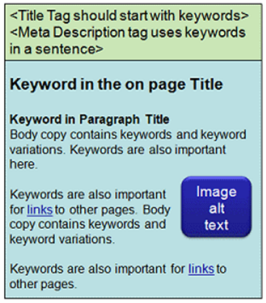 This is post #5 in a series of 10 on the intersection of PR and SEO. We’ll discuss a few best practices content SEO tactics as well as a few things to avoid.
This is post #5 in a series of 10 on the intersection of PR and SEO. We’ll discuss a few best practices content SEO tactics as well as a few things to avoid.
While there is much to understand about successfully implementing and maintaining search engine optimization efforts, there are a few fundamental concepts worth starting with, including the notion of quantity, quality and time as appropriate to content and links. For the most part, the more web pages, digital assets and inbound links, the better the search visibility. Each link is a conduit and each page is a potential entry point into the web site.
As a general guideline, the same is true with quality. The higher quality content and link sources, the more competitive advantage for better search results.
Search Engine Optimization professionals can be instrumental in advancing the SEO Quantity and Quality measures. Time, on the other hand, cannot be “facilitated”. The longer a site has been known to a search engine, including web pages and the links pointing to those pages, the better. That means making sure search engine spiders can find your content from day one and then again on day two, three, etc.
This SEO trifecta is meaningful for the intersection of PR and SEO because it also means understanding and appreciating the value of long time news content hosted on your site and not deleting it because of the perception that it’s no longer current. Older news content can be removed and the pages permanently redirected to newer, relevant content or relevant category pages. Press releases and past media coverage are good examples of content that is often removed or archived after a certain period of time.
Links that have been in place for a long time from authoritative news sites should also be appreciated and cared for. For example, if multiple mainstream publications link to a certain news release within the newsroom, removing that page means eliminating the PageRank value passed from the external links. Inbound links from authoritative web sites like mainstream publications can be instrumental for search engine visibility.
Another issue that wreaks unnecessary havoc concerns changing to a different content management system or changing the design of an online newsroom. The new newsroom might look good, but if the URL structure and syntax changes, the search engines can get very confused and any inbound link popularity to old URLs will be lost. Imagine a friend getting major plastic surgery: It would be confusing at first. Search engines can get even more confused.
Implementing a SEO migration plan of old content and URLs to new is essential for minimizing the lost value of long time content and links.

Basics of On-Page SEO for News Content:
On page fundamentals start with including keywords in titles and names. As in, Title tags, on page titles, file (page, image, media) and directory names as well as HTML attributes such as alt text for images, anchor text for links to other pages on the site and using H1 for headings.
These on-page SEO tactics are for situations where there is a certain amount of control over web content. Some content management systems allow little more than page creation and newswire services, while flexible, do not offer full HTML editing. So it’s important to do the things that are possible and work with the web development team to make any programming changes that can have a substantial, positive impact like making title tags editable.
When optimizing news content, whether it’s press releases, case studies, white papers, past media coverage or executive videos and photos, there are a set of basic site optimization guidelines to follow like a checklist that can help ensure the publishing of more search engine friendly content:
- Research and map target keywords at the category or page level
- Ensure the site is crawlable by search engine bots/spiders
- Keyword optimize content: Title tags, on-page titles, section headings, body copy, link text between pages, image alt text, navigation text and footer text.
- Where does the page fit within the Content Strategy: ongoing content creation, optimization and promotion
- Where does the page fit within the Linking Strategy: ongoing link acquisition and monitoring
- What analytics and measurement tools are in place to benchmark and gauge search performance
In order for on-page keyword optimization of news content to be effective for an organization, it should be complimented with ongoing training for anyone in a position to add PR related content or acquire an inbound link. Making content optimization and link acquisition part of a regular process enables companies large and small to incorporate SEO benefit into the overall content and marketing strategy.
We’ve posted another series focused on general SEO Basics here that may be helpful:
- The Yin and Yang of PR and SEO
- SEO Basics: Top 3 Tactics To Improve Search Engine Rankings
- SEO Basics: Ensure Your Site Can be Crawled by Search Engines
- SEO Basics: Unlocking Content for Search Engines
- SEO Basics: Are Directory Submissions Still Worthwhile?
- SEO Basics: 4 Tips to Improve Search Engine Rankings
- SEO Basics: 6 Tips for Google Webmaster Tools
This is #5 in a series of ten posts discussing tactics for effective news optimization, “Top Ten SEO Tips for Public Relations“. Tomorrow we’ll be posting #6, “Press Release Optimization Tips“.


